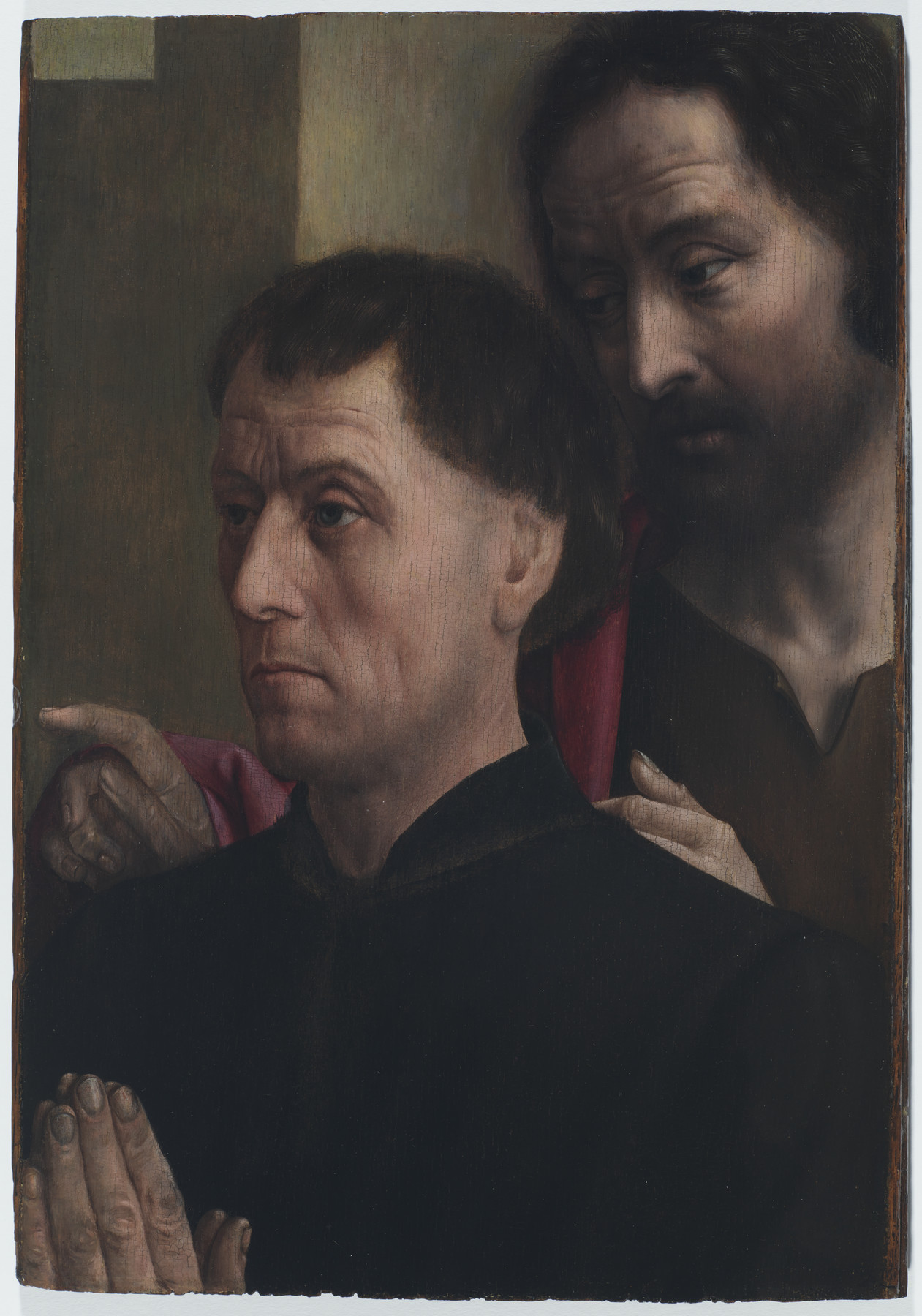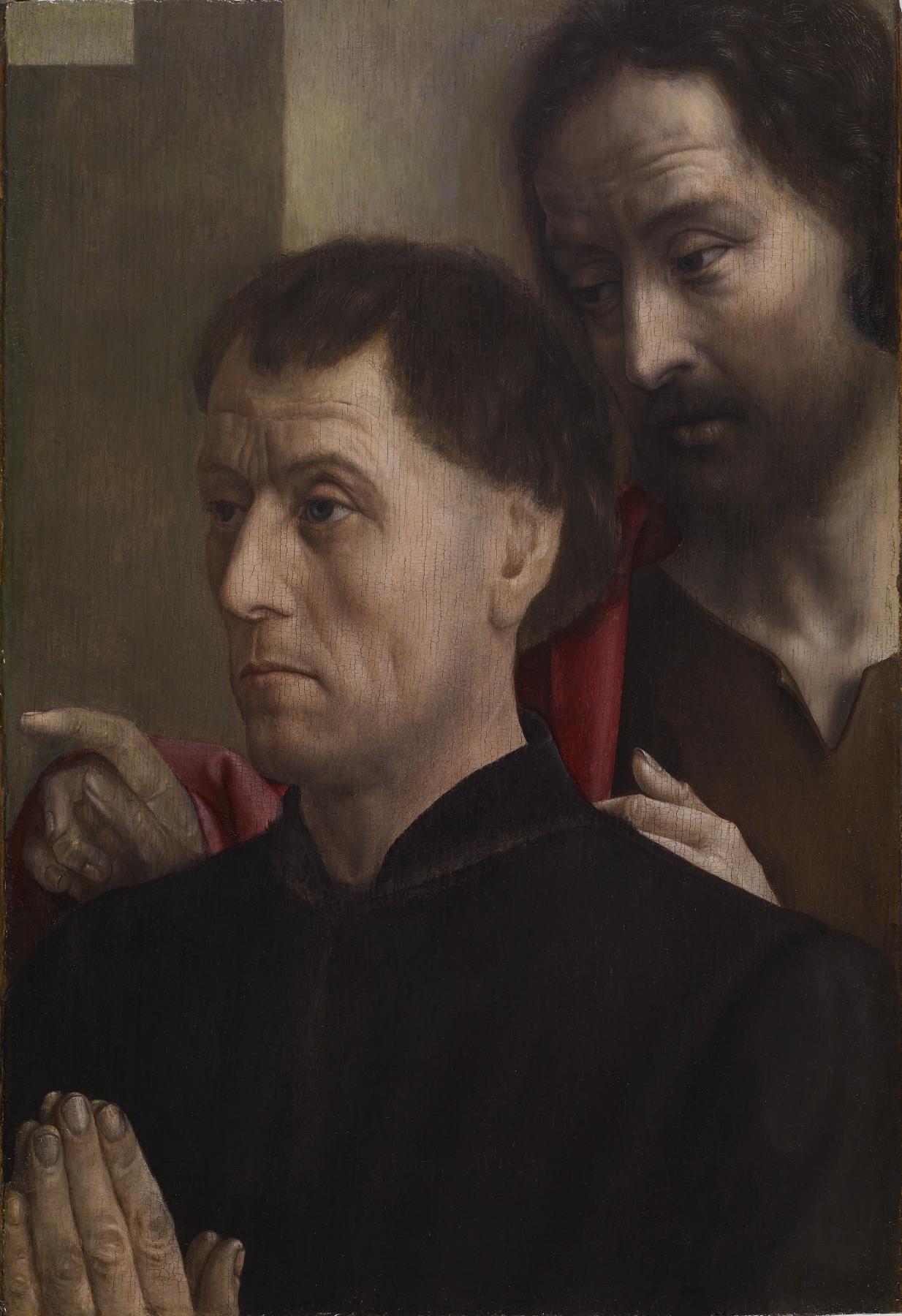Portrait of a Man at Prayer with Saint John the Baptist
(Renaissance Europe )
Hugo van der Goes (active ca. 1440-1482) was one of the major portraitists of 15th-century Europe, at a time when portraiture gained importance under the impact of the new individualism fostered by humanism. A common type of portrait was the depiction of a man or woman in prayer, experiencing a vision, often of the Virgin. This small panel, cut down slightly at the top and bottom, was originally the right wing of a small altarpiece made of only two paintings, known as a diptych. The subject of the left wing would have been the Virgin and Child. It is to them that Saint John directs the praying donor's devotion.
This unidentified donor (the person who donated or commissioned the work of art) is shown completely absorbed in the vision of the Virgin and Child. During this period, it was thought inappropriate to show strong emotion in public, but Hugo was very sensitive to the most subtle facial expression that give clues to a person's mental state. The man's deep concentration is wonderfully captured in his raised eyebrow and contracted muscles around the mouth.
Provenance
Provenance (from the French provenir, 'to come from/forth') is the chronology of the ownership, custody, or location of a historical object. Learn more about provenance at the Walters.
P. A. Borger, Arnheim; Sale, Frederick Muller et Cie., Amsterdam, November 13, 1882, no. 16; L.(?) M. Leembruggen, Amsterdam [date of acquisition unknown], by purchase; Rijksmuseum Amsterdam, 1903, by long-term loan; Sale, Frederick Muller et Cie., Amsterdam, April 13, 1920, no. 66; Private collection, New York (?); J. Seligmann and Co., Paris and New York [date of acquisition unknown], by purchase; Henry Walters, Baltimore, 1920, by purchase; Walters Art Museum, 1931, by bequest.
Exhibitions
| 2023 | Hugo van der Goes. Gemaldegalerie, Berlin. |
| 2019-2021 | Excursions through the Collection: Portraiture, Adornment, and the Natural World. |
| 2010-2011 | From Van Eyck to Dürer: Artistic Exchanges between the Netherlands and Centeral, Eastern and Northern Europe c. 1420-1530. Groeningemuseum, Brugge. |
| 1998-2001 | Highlights from the Collection. The Walters Art Gallery, Baltimore. |
| 2000 | Small Northern European Portraits from The Walters Art Gallery, Baltimore. National Gallery of Art, Washington. |
| 1984 | The Taste of Maryland: Art Collecting in Maryland 1800-1934. The Walters Art Gallery, Baltimore. |
| 1980 | Salute to Belgium. The Walters Art Gallery, Baltimore. |
Conservation
| Date | Description | Narrative |
|---|---|---|
| 2/10/1939 | Treatment | mounted; re-housed; loss compensation; coated; other |
| 2/29/1960 | Treatment | cleaned; coated |
| 2/29/1960 | Examination | examined for exhibition; examined for loan |
| 1/17/1961 | Examination | examined for exhibition |
| 2/25/1986 | Treatment | coated; other |
| 7/18/1986 | Examination | examined for technical study |
| 7/18/1986 | Examination | examined for condition |
| 8/22/1986 | Treatment | loss compensation; coated |
| 10/1/1986 | Treatment | cleaned; loss compensation; coated |
| 10/22/1988 | Technical Report | examined for technical study |
| 10/23/1988 | Examination | examined for condition |
| 10/28/1988 | Examination | examined for technical study |
| 3/1/2000 | Treatment | cleaned; coated |
| 10/20/2009 | Loan Consideration | examined for loan |
| 10/20/2009 | Examination | examined for exhibition; examined for loan |
| 4/1/2011 | Treatment | other |
Geographies
Belgium, Brussels
(Place of Origin)
Belgium, Ghent (Place of Origin)
Measurements
H: 12 5/8 x W: 8 7/8 x D: 1/4 in. (32 x 22.5 x 0.6 cm)
Credit Line
Acquired by Henry Walters, 1920
Location in Museum
Centre Street: Third Floor: 15th-Century Art of Northern Europe
Accession Number
In libraries, galleries, museums, and archives, an accession number is a unique identifier assigned to each object in the collection.
In libraries, galleries, museums, and archives, an accession number is a unique identifier assigned to each object in the collection.
37.296




